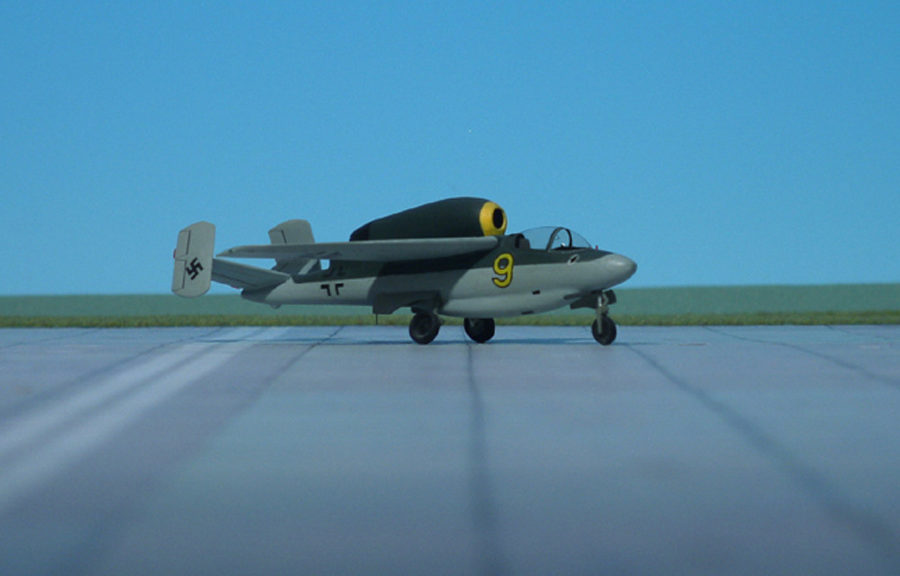TYPE: Fighter project, forerunner of the Heinkel He 162
ACCOMMODATION: pilot only
POWER PLANT: one Heinkel-Hirth HeS 011 turbojet engine, rated at 1.300 kp thrust
PERFORMANCE: 615 mph in 19615 ft
COMMENT: The summer 1944 saw limitations of the Messerschmitt Me 262 becoming readily apparent. The basic design predated the war. It was heavy and expensive, and required to precious turbojet engines. A cheap high-performance replacement was needed so in July 1944 the RLM issued a requirement for a new single-turbojet high-performance fighter, known as the “1-TL-Jäger”. Germany’s aircraft companies were quick to realise that this was potentially the most important competition in which they had so far had the opportunity to participate. Designing a successful single-seat fighter carries a huge amount of prestige and the most famous firms – Blohm &Voss, Focke-Wulf , Heinkel, Junkers and Messerschmitt – jumped at the chance to create the successor to not only on the me 262 but perhaps also the Bf 109 and Fw 190 too. The engine was to be a Heinkel-Hirth HeS 011 turbojet and the companies were allowed two months to prepare their first designs, Blohm & Voss had two months more time.
On September 1944 the designs were presented at a meeting at Messerschmitt’s Oberammergau facility. It is not known which designed were presented by Messerschmitt and Heinkel, though it is likely that these were one of the earliest versions of the former’s Me P.1101, and the latter’s He P.1073 or a variant of it. Focke-Wulf put forward a twin-boom design Nr.280 it had been working on since early 1944. Blohm & Voss’s design (P.212) was apparently not ready and furthermore it was agreed that Junkers should also be allowed to submit a tender for the requirement.
On the last day of the meeting, a new requirement was suddenly and for most part unexpectedly issued for what would become the “Volksjäger” (Peoples Fighter). This called for a fighter powered by a single BMW 003 turbojet engine that could reach a maximum speed of 466 mph and have an endurance of 30 minutes at full throttle. It also had to be able to operate from poor airfields.
This urgent demand for new single-turbojet fighter designs that could be built in a hurry from low grade non-strategic materials effectively stalled work on the “1-TL-Jäger” competition for several months, particularly Blohm & Voss, Focke-Wulf, Heinkel and Junkers all hastily drafted entries for the “Volksjäger” contest.
The Heinkel He P.1073, originally designed before July 1944 as a fighter with two Junkers Jumo 004C turbojet-engines, one under the nose and one at its back but now altered to fly with just one Heinkel-Hirth HeS 011, was already close to meeting the “Volksjäger” specification. The Heinkel “Volksjäger”-design He P.1073.01.18 was dated from September 1944, just one day after the specification was issued. This only was possible because Heinkel’s design team had several different variants of the design on the drawing board. The documentation describes the He P.1073.01.18 as a “Kleinst-Jäger” (Midget Fighter) and states it is ”a simplification of the design with HeS 011”. It bears remarkable resemblance to what would become the Heinkel He 162 “Spatz” (Sparrow”) except the wings are simpler and both nose wheel and main gear retract forward into the fuselage. Heinkel’s design received a similarly lukewarm reaction, probably because it was based heavily on the company’s already known “1-TL-Jäger” project. But Heinkel’s representatives pointed out that with aircraft such as the Heinkel He 177 bomber no longer in production there was now spare capacity available at its capacious and well-equipped factories. There is some evidence that on September 23rd 1944 Hitler himself ordered the He P.1073 into mass production as Heinkel He 162.
The variant of the He P.1073 design that finally led to the definitive Heinkel He 162 “Volksjäger” is shown here. The design is dated back from September 10th, 1944 and shows the installation of the turbojet engine on the back. The wings are swept back at 35 degree, the tail plane had a positive dihedral and two fins. Under the fuselage on ventral starboard side a streamlined pannier was fitted holding a MK 108 machine canon and two MG 213C machine guns were oblique mounted in the front at both sides of the pilot’s seat. Work on the final version of the Heinkel “Volksjäger began on October 25th, 1944 and its maiden flight took place on December 6th that year (Ref.: Sharp, Dan: Luftwaffe. Secrets Jets of the Third Reich. Mortons Media Group Ltd, Horncastle, 2015).













